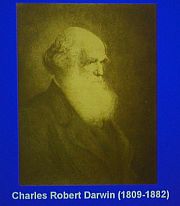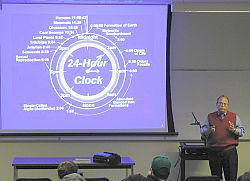
EARTH'S EARLIEST
FOSSILS:SOLUTION TO DARWIN'S DILEMMA
Dr. William Schopf - Professor
of Paleobiology, UCLA
 Professor William Schopf (right) with MTU Geology Professor James R. Wood |
In 1859, in On the Origin of Species, Darwin repeatedly pointed to what he viewed as the greatest challenge facing his theory of evolution -- the lack of a rich fossil record predating the rise of shelly invertebrate animals that marks the beginning of the Cambrian Period of geological time (~550 million years ago).
 A
scientist to the core, Darwin faced the problem straight on, arguing that
the lack of such a record was "inexplicable" -- an absence that
could be "truly urged as a valid argument" against his theory.
For more than 100 years, the missing Precambrian history of life stood
out as one of the greatest unsolved mysteries in natural science. In recent
decades, however, life's early history has finally begun to be unearthed
as the documented fossil record has been extended to some 3,500 million
years ago, an age more than three-quarters that of the planet itself.
As this new science has matured, hundreds of ancient fossiliferous units
have been discovered and the rules for accepting ancient microfossil-like
objects as bona fide have come to be well established -- namely, that
such objects be demonstrably biogenic, and indigenous to and syngenetic
with the formation of rocks of known provenance and well-defined Precambrian
age.
A
scientist to the core, Darwin faced the problem straight on, arguing that
the lack of such a record was "inexplicable" -- an absence that
could be "truly urged as a valid argument" against his theory.
For more than 100 years, the missing Precambrian history of life stood
out as one of the greatest unsolved mysteries in natural science. In recent
decades, however, life's early history has finally begun to be unearthed
as the documented fossil record has been extended to some 3,500 million
years ago, an age more than three-quarters that of the planet itself.
As this new science has matured, hundreds of ancient fossiliferous units
have been discovered and the rules for accepting ancient microfossil-like
objects as bona fide have come to be well established -- namely, that
such objects be demonstrably biogenic, and indigenous to and syngenetic
with the formation of rocks of known provenance and well-defined Precambrian
age.
In the past few years, two new techniques have been devised to help answer the question of biogenicity, the most vexing of the criteria to satisfy. Founded on firm understanding of the morphology and physiology of extant microorganisms and a large body of data on the maturation of organic matter in geologic settings, for the first time these techniques provide means to correlate directly cellular morphology with organic composition in individual Precambrian microscopic fossils.
(1) Ion microprobe spectroscopy has been used to measure the carbon isotopic composition of single microscopic fossils (1,2), analyses that provide evidence of their ancient physiologies.
(2) Laser-Raman imagery has been used to determine the chemical-structural composition of such fossils -- both in two and in three dimensions(3-5) -- data that confirm the biological origin of the carbonaceous matter comprising their petrified cell walls and that demonstrate the presence of cell lumina, the cellular spaces that define biological systems. After more than a century of unrewarded search, an immense early fossil record, unknown and assumed unknowable, has been unearthed to reveal a microbe-dominated evolutionary progression that stretches seven times farther into the geologic past than had previously been imagined.
